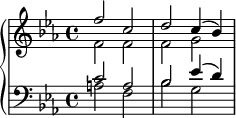45.—In music which is not part-writing, the transcriber will have to use his discretion as to the repetition of accidentals which have already appeared in another "part" in the same measure. The guiding principle will be to avoid the likelihood of error on the part of a competent reader.
46.—Care must be taken to turn the stems of half notes and shorter notes according to the principles of short score, and not necessarily as they are in the open score.
Short Score
to Open
Score.
47.—Co-relatively, in transcribing from short score to open, it will occasionally be necessary to put accidentals in the latter which are not in the former. The commonest form of this is probably in extracting a single part, soprano, alto, tenor, or bass, from an ordinary short score hymn or chant book, and writing it in a part-book for the particular voice. Thus, in transcribing the tenor of the following extract from the hymn-tune "Heathlands" into a part-book, it would be necessary to insert a natural before the A.

Fig. 37.

